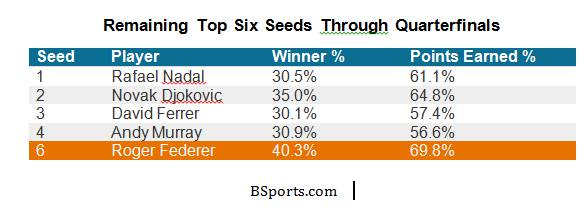by Josh Bramblett, iTPA Staff
After the 2013 season, Roger Federer has dropped in the rankings from number 2 in the world to number 6. Not making a grand slam final since 2002, Roger decided to make some drastic changes. He changed his coach, adjusted racquet head size from 90 square inches to 98 square inches, and reset mentally ready to start anew.
The 2014 Australian Open is the first major viewing point of how Federer will deal with all these changes. So far they seem to be paying off. Flying through his first 4 matches, Federer is into the quarterfinals to face his young rival Andy Murray who is coming off his best year on tour. In 2013, Federer went 0-7 against the other members of the big 4 (Nadal, Djokovic, Murray, Federer) Going into the quarterfinal match Federer’s serve has been unstoppable. He has only been broken once in the tournament and his service numbers are higher than the whole 2013 season.
Murray: 21 aces, zero doublefaults, 64 percent first serves, 63 percent second serve points won, 62 winners, 47 unforced errors, for a +15 differential.
Federer: 5 aces, 2 doublefaults, 61 percent first serves, 42 percent second serve points won, 43 winners, 60 unforced errors, for a -17 differential.” (Roger, 2013)
Looking at Federer’s serve statistics in the 2014 Australian Open it certainly shows his game has progressed. With Federer’s game improving, he defeated Andy Murray winning 6-3, 6-4, 6-7, 6-3 to earn a spot in the semi-finals.
This year’s semifinal draw looks completely different from 2013. Federer is the only remaining player that made it to the semifinals in 2013. In addition, last year's draw had the 4 top seeded players make it to the semi-final: Andy Murray, Roger Federer, David Ferrer, and Novak Djokovic. This year is very rare with only 1 of the top 4 seeded players making it to the semifinals. Why is this year's Australian Open so different from 2013? What has changed?
Federer has shown he is committed to returning to 1 of the top 4 players in the world. He has relegated going back home (to Switzerland) for the holidays to continue training in Dubai. Federer has also started his Australian Open campaign earlier than usual by playing at the Brisbane International Tournament. Rafael Nadal is also back to reclaim a second Australian Open (the only Grand Slam he has not won twice). Nadal’s presence affects the draw; without him Djokovic and Murray would be on opposite sides and Federer would be on the same side as Djokovic. Although Roger ultimately came up short against Nadal, it does show positive signs for him for the remainder of 2014.
Another factor is the heat wave in the first week of the tournament. Could the heat wave have possibly had an energy depleting effect on some of the players? Or have the other players in the top 10 (Tomas Berdych and Stanislas Wawrinka - semifinalist) stepped up, determined to reach their potential?
References
Brown, S. (Jan. 20, 2014). Roger Federer’s Start to the Australian Open. BSports. Retrieved from http://www.bsports.com/statsinsights/tennis/roger-federers-start-australian-open
Roger Federer vs. Andy Murray: Australian Open live analysis, (2013). Retrieved from http://tennis.si.com/2013/01/25/roger-federer-andy-murray-australian-open-live-analysis/






 RSS Feed
RSS Feed
